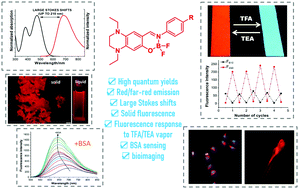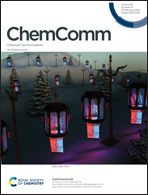Red-emitting boron difluoride complexes with a mega-large Stokes shift and unexpectedly high fluorescence quantum yield†
Abstract
Introduction of a tetrahydroquinoxaline donor into boron difluoride complexes largely extended their emissions (617–684 nm), highly improved their fluorescence quantum yields (up to 0.68) and greatly increased their Stokes shifts (up to 209 nm). These new fluorescent dyes showed reversible ratiometric solid-state fluorescence changes upon switched acid/base fumings. Significantly, these boron difluoride complexes were successfully utilized as imaging agents in living cells and zebrafish.



 Please wait while we load your content...
Please wait while we load your content...